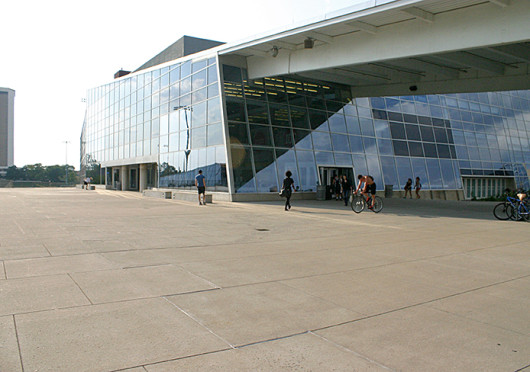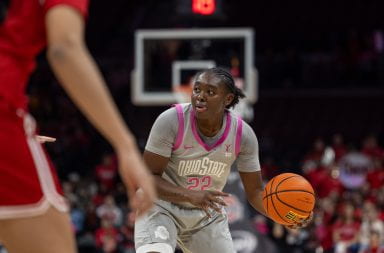
The RPAC, located at 337 W. 17th Ave., opened in August 2005. OSU Recreational Sports is celebrating its centennial during October.
Credit: Lantern file photo
From vacant fields and gender-segregated buildings to modernized facilities, 100 years have changed the way Ohio State students exercise.
OSU Recreational Sports, part of the Office of Student Life, will be celebrating its centennial at the end of October to recognize the progress the department has made with facilities, student participation, programming and leadership over the past 10 decades.
Even before recreational sports were officially recognized at the university, OSU students engaged in informal baseball games. It wasn’t until 1913, though, that a group of male students discussed the idea of having a more organized structure to recreational sports on campus, said Marci Shumaker, senior associate director for administration and programs for Recreational Sports.
According to The Lantern archives, in an issue dated Dec. 10, 1913, football coach John Wilce wrote about his desire to introduce intramural sports to the university. Wilce was appointed the first director of the program that year.
“Every student should at least have had the chance during his college career to have obtained the social and moral benefits of membership on some athletic team and opportunities should be given to him to form habits of recreational play which will be of value to him after college,” the article read.
The Department of Competitive and Recreational Athletics was created that year, and by January 1914, the Department of Intramural Sports was officially the first in the nation to offer intramural soccer, football, track and cross country, according to the department’s website.
“You can see a really natural progression of students independently doing activities on their own to the university recognizing that there’s a need for that to be more coordinated,” said Don Stenta, current director of Recreational Sports.
Despite student initiative for a more organized program, not everyone was immediately able to actively participate. Male students used their own gymnasium, which later became Larkins Hall as part of a 1977 project to build new recreational centers that cost $10 million at the time, while females utilized Pomerene Hall until Larkins became gender-integrated, Shumaker said.
In the Oct. 21, 1975, issue of The Lantern, Fred Beekman, who was named director of the program in 1962, was quoted on the involvement of women in athletics.
“It’s just become accepted that women can compete now,” Beekman said. “I think there was a time when girls didn’t want to be called tomboys, but now everybody just wants to have a good time. I think growth will continue.”
Shumaker said students who participate in the recreational programs have become more diverse over the years.
“We’ve made them (the programs) accessible, and I think that’s the greatest thing, is that now we can say pretty much everything we offer anybody can do and that hasn’t always been the case through history,” Shumaker said.
The types of activities that have garnered students’ interest have changed throughout the decades, Stenta said, adding that a number of sports have made appearances on campus, but some eventually fade away with time. He said some activities, such as kin-ball, which is a three-team sport played with an oversize ball, and big wheel racing, which involves racing on a tricyle with an extra large front wheel, could return to popularity.
“It really is cyclical and it’s fun to see what used to happen and what we can bring back,” Stenta said.
The type of sports offered in the intramural program has gone through many transitions in the last century, as has leadership of the department. Wilce, Leo Staley, Beekman and J. Michael Dunn were among those who preceded Stenta, who took the position in 2011, as director.
Stenta said each individual brought something unique to Rec Sports.
“Every director took it to that next level in terms of enhancing the campus by way of student experience or by way of major facility enhancement so we’re really proud of the accomplishments they all made,” Stenta said. “We’re the department we are today because of them.”
Other noticeable changes in the department have included the development of more facilities for recreational use.
David DeAngelo, senior associate director of facilities, has worked for the department for 13 years and was also a student at OSU for seven years. Since arriving on campus as a student in 1988, DeAngelo said he has seen the opening of the RPAC, Outdoor Adventure Center, Adventure Recreation Center and Fred Beekman Park, all of which he called “transformative” for improving the quality of Recreational Sports at OSU.
DeAngelo, however, said he would like to see the department continue to grow.
“A hundred years from now when the next group of people are celebrating their bicentennial, hopefully they’ll be able to talk about even more facilities and expanded programs,” he said. “We continue to put great people into the field.”
Overall, Stenta said the key to the success of Recreational Sports was set from the beginning.
“It’s a great example of when you build a strong foundation, something can last for a long time and it can get better and better with age,” he said.
A centennial celebration is set to take place Friday at 5 p.m. in the RPAC.


